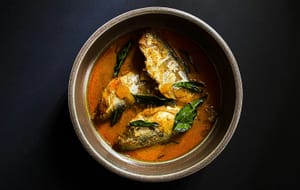Building space opera worlds, one meal at a time.
by Ursula Whitcher
In a genre like space opera, where characters travel huge distances and visit planets that don’t exist, a sensuous food description can make an entire universe seem more real. But ill-thought-out details can accentuate a story’s artificiality. Diana Wynne Jones joked about ‘80s sci-fi that rebranded the ubiquitous coffee as kivay or xfy. A creepier phenomenon arises when writers borrow a real-world food culture without letting that culture impact other aspects of their worldbuilding: it’s the culinary equivalent of Firefly’s Chinese dialogue and not-at-all-Chinese cast.
Effective food descriptions have to convey setting, character, and a sensory impression of the food itself, without making readers feel like they’ve stumbled into a recipe book. Here are some of my own favorite space opera meals, from the vantage of both a reader and a writer.
Dumplings are crowd-pleasers. It’s easy for me to riffle through happy dumpling
memories: squeezing into a booth to taste soup dumplings at the edge of a California mall, struggling to close a single dumpling top while a mathematical colleague formed one round dumpling after another, ordering an entire tray of lamb dumplings in a bustling Montreal restaurant and discovering that the herb whose name I didn’t recognize was crunchy, aromatic dill. Aliette de Bodard’s Xuya universe draws on Vietnamese history and literature—there are scholars seeking court favor and bureaucrats punishing or promulgating injustice—and it’s full of Vietnamese-style dumplings. Here’s an example from the spaceship Rice Fish’s perspective, in The Red Scholar’s Wake:
Rice Fish sat cross-legged in front of the table, picked up a dumpling, and ate it.
It was a virtual one, of course—and as it slid inside her mouth the black vinegar spiked sharply against Rice Fish’s virtual palate, and she was young again, watching her baby sibling dribble sauce all over her own floors—hearing her mother sharply call their name. ‘Thanh, don’t bother your sister!’ And the baby just laughed and laughed, running their fingers through the sauce…
The mindship’s dumplings don’t just evoke memory—they’re made from it. Writing an artificially intelligent character whose experiences have sensory immediacy can be tricky, and the virtual food made of memories solves this problem (I resorted to giving a spaceship synesthesia in my forthcoming story “A Fisher of Stars”).
In this case, Rice Fish’s memories are all about family. That’s a key part of Xuya culture in de Bodard’s writing: mindships and humans form families together. Though the ships are huge and powerful (and expensive to maintain), they are bound by the same ties of love and obligation as their human siblings. In this scene, Rice Fish is wondering whether her newfound relationship with a human woman can last—whether they are truly family in the ways that matter—and the
wave of love and nostalgia brought by dumplings only heightens her concerns.
In Arkady Martine’s novel A Desolation Called Peace, delicious food contrasts with a hostile conversation:
The danger here wasn’t going to come from the food. In fact, it smelled good enough to make Mahit’s mouth water: the flaky fish spiced with red peppers, the carbon-scent of slightly charred flatbread, made from real wheat and precious thereby. Amnardbat sat across from each other, and for a good two minutes they were just Stationers together: rolling flatbread around fish, devouring the first one and making another to be eaten more slowly.
Mahit and the Council member she distrusts, Amnardbat, are on Lsel Station. Martine based much of Lsel’s culture and political situation on medieval Armenia, a subject of her PhD dissertation in history. The flatbread (lavash) and the peppers used as seasoning are part of modern Armenian cuisine. But the cheap and expensive parts of the meal are reversed from real-world patterns: on Lsel Station, it’s easy to grow fish in vats, but wheat is fetched from a planet at enormous expense. That discrepancy between our world and Mahit’s emphasizes her growing
sense that she is caught between cultures, at home neither on her own station nor in the empire to which she is supposedly ambassador.
I think a lot about technologies of food production when I’m writing, both in the large-scale sense of agriculture and the small-scale sense of who does the cooking. In my story “Closer Than Your Kidneys” for Frivolous Comma, the final confrontation involves a tense conversation over a mint drink made with yogurt—“We called it yogurt, though on the hundredships it was mostly made of beans.” The hundredships are spaceships that make up a nomadic convoy. The
yogurt drink is similar to Turkish ayran or a lightly sweetened mint lassi, but since the ships can’t support dairy herds, they make do with something like soy milk.
“Kidneys” is the first story in my collection of same-universe stories North Continent Ribbon, which is coming out from Neon Hemlock Press later this year (check out their Kickstarter!) The narrator of “Kidneys” is a working assassin, and most of her food comes from spaceship cafeterias. But even when her people leave their wandering hundredships and settle on a planet, cooking at home remains rare. When Sannali Emenev wants to flirt with a glamorous spy a few centuries later, he offers “a tray with luxurious and unlaborious foods: cubes of melon
fresh from the mountains, pâté of duck marbled with berries, crackers with sesame and black cumin.” Emenev is nerdy about food, but he’s used to getting by on institutional meals and takeout. He’s keenly aware that though he has done well for himself and bought a house with its own kitchen, most of the people in the city he runs have nothing of the sort.
Some of this dynamic comes from my research into the history of food. Americans tend to take stoves for granted—but in older cities, fire was a constant threat, and kitchens were the province of tavernkeepers, the servants of the wealthy, and other professionals. My spacefaring civilization has its own anxieties about fire and its own class divisions. Some of these are familiar, and some (like the fact that army enlistment comes with a commitment to growing wheat) are entirely invented.
Writing imaginary food gives writers a way to draw on the tension between what
characters find familiar and what’s comforting for the reader, either by intensifying the sense of comfort or by heightening the contrasts. That can be an incredibly powerful tool—or a reason to explore our own assumptions about what’s most appetizing!
Ursula Whitcher is a writer, poet, and mathematician whose favorite
dumpling sauce is soy with black vinegar and whose first story
collection, North Continent Ribbon, will be published by Neon Hemlock
Press. Follow Ursula at https://buttondown.email/yarntheory or
@yarntheory.bsky.social on Bluesky.

